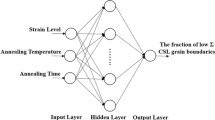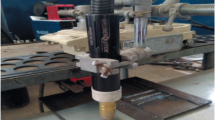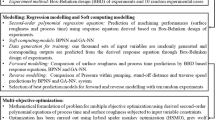Abstract
In this research work, the optimization of a back-propagation artificial neural network (BPNN) using a new multi-objective bio-inspired algorithm based on squirrels is proposed in order to optimize the main continuous galvanizing process parameters such as the initial cooling rate (CR1), the isothermal holding time at 460 oC (tg), and the final cooling rate (CR2). The computational approach predicts in a satisfactory way the most important mechanical properties including yield strength (YS), ultimate tensile strength (UTS), and elongation at fracture (EL) of cold rolled low carbon DP steels treated under continuous galvanizing thermal cycle conditions. The experimental production of galvanized ultra-high-strength DP steels from cold rolled low carbon sheets with a minimum UTS of 1100 MPa, YS between 550 and 750 MPa, and a minimum elongation of 10% is possible using the proposed methodology.







Similar content being viewed by others
References
Alibeigi S, Kavitha R, Meguerian R, McDermid J (2011) Reactive wetting of high Mn steels during continuous hot-dip galvanizing. Acta Mater 59:3537–3549
Bahrami A, Anijdan SM, Ekrami A (2005) Prediction of mechanical properties of dP steels using neural network model. J Alloys Compd 392:177–182
Baykasoğlu A., Baykasoğlu C., Cetin E (2020) Multi-objective crashworthiness optimization of lattice structure filled thin-walled tubes. Thin-Walled Struct 149(106):630
Bezerra M, Santelli R, Oliveira E, Villar L, Escaleira L (2008) Response surface methodology (RSM) as a tool for optimization in analytical chemistry. Talanta 76:965–977
Bräutigam–Matus K, Altamirano G, Salinas A, Flores A, Goodwin F (2018) Experimental determination of continuous cooling transformation (CCT) diagrams for dual-phase steels from the intercritical temperature range. Metals 8:1–16
Caballero R, González M, Guerrero F, Molina J, Paralera C (2007) Solving a multiobjective location routing problem with a metaheuristic based on tabu search. application to a real case in andalusia. Eur J Oper Res 177:1751–1763
Calcagnotto M, Ponge D, Raabe D (2012) Microstructure control during fabrication of ultrafine grained dual-phase steel: characterization and effect of intercritical annealing parameters. ISIJ Int 52:874–883
Costa P, Altamirano G, Salinas A, González-González D, Goodwin F (2019) Optimization of the continuous galvanizing heat treatment process in ultra-high strength dual phase steels using a multivariate model. Metals 9:1–17
Cota A, Modenesi P, Barbosa R, Santos D (1999) Determination of CCT diagrams by thermal analysis of a HSLA bainitic steel. Scr Mater 40:165–169
Dutta T, Dey S, Datta S, Das D (2019) Designing dual-phase steels with improved performance using aNN and gA in tandem. Comput Mater Sci 157:6–16
Flaxa V, Shaw J (2002) Material applications in ULSAB-AVC (advanced vehicle concepts). In: International body engineering conference & exhibition and automotive & transportation technology congress, pp 1–8
Fonstein N (2015) Advanced high strength sheet steels: physical metallurgy, design, processing, and properties. Springer , Berlin
Galán J, Samek L, Verleysen P, Verbeken K, Houbaert Y (2012) Advanced high strength steels for automotive industry. Rev Metal 48:118–131
Ghassemi-Armaki H, Maaß R, Bhat S, Sriram S, Greer J, Kumar K (2014) Deformation response of ferrite and martensite in a dual-phase steel. Acta Mater 62:197–211
Granbom Y (2008) Effects of process parameters prior to annealing on the formability of two cold rolled dual phase steels. Steel Res Int 79:297–305
Han Y, Kuang S, Liu H, Jiang Y, Liu G (2014) Research of microstructure and mechanical properties of the cold rolled hot-dip galvanizing DP450 steel with low carbon and high chromium. Adv Mater Res 1004-1005:188–192
Haque ME, Sudhakar K (2001) Prediction of corrosion–fatigue behavior of DP steel through artificial neural network. Int J Fatigue 23:1–4
Haque ME, Sudhakar K (2002) ANN back-propagation prediction model for fracture toughness in microalloy steel. Int J Fatigue 24:1003–1010
Hosseini S, Zarei-Hanzaki A, Panah MY, Yuec S (2004) ANN model for prediction of the effects of composition and process parameters on tensile strength and percent elongation of Si–Mn tRIP steels. Mater Sci Eng A 374:122–128
Huseyin A, Havva K, Ceylan K (2010) Effect of intercritical annealing parameters on dual phase behavior of commercial low-alloyed steels. J Iron Steel Res Int 17:73–78
Jain M, Singh V, Rani A (2019) A novel nature-inspired algorithm for optimization: Squirrel search algorithm. Swarm Evol Comput 44:148–175
Jamwal R, Frimpong J, Ehrhardt B, Bracht H, Boggs R, SW B (2014) Process for making cold-rolled dual phase steel sheet
Khondker R, Mertens A, McDermid JR (2007) Effect of annealing atmosphere on the galvanizing behavior of dual-phase steel. Mater Sci Eng A 463:157–165
Kim S, Cho Y, Oh C, Kim D, Moon M (2009) Development of a dual phase steel using orthogonal design method. Mater Des 30:1251–1257
Krajewski S, Nowacki J (2014) Dual-phase steels microstructure and properties consideration based on artificial intelligence techniques. Arch Civ Mech Eng 14:278–286
Kuang S, Kang Y, Yu H, Liu R (2009) Effect of continuous annealing parameters on the mechanical properties and microstructures of a cold rolled dual phase steel. Int J Min Met Mater 16: 159–164
Pan E, Di H, Jiang G, Bao C (2014) Effect of heat treatment on microstructures and mechanical properties of hot-dip galvanized DP steels. Acta Metall Sin 27:469–475
Pleschiutschnigg F, Jamnis V, Talwar S, Misra A, Atluri R, Singh R, Shankar P, Verma R, Goyal R, Mishra V, Deepu B, Meierling P, Pleschiutschnigg J (2004) Start of dual-phase hot strip production in the MPS. Dolvi plant of Ispat Industries Ltd. in India. Steel Grips 2:171–176
Rashid M (1981) Dual phase steels. Annu Rev Mater Sci 11:245–266
Schmitt J, Iung T (2018) New developments of advanced high-strength steels for automotive applications. Comptes Rendus Physique 19:641–656
Sterjovski Z, Nolan D, Carpenter K, Dunne D, Norrish J (2005) Artificial neural networks for modelling the mechanical properties of steels in various applications. J. Mater Process Technol 170:536–544
Tasan C, Diehl M, Yan D, Bechtold M, Roters F, Schemmann L, Zheng C, Peranio N, Ponge D, Koyama M, Tsuzaki K, Raabe D (2015) An overview of dual-phase steels: advances in microstructure-oriented processing and micromechanically guided design. Annu Rev Mater Res 45:391–431
Vafaeenezhad H, Ghanei S, Seyedein S, Beygi H, Mazinani M (2014) Process control strategies for dual-phase steel manufacturing using ANN and ANFIS. J Mater Eng Perform 23(11):3975–3983
Wang Y, Du T, Liu T, Zhang L (2019) Dynamic multiobjective squirrel search algorithm based on decomposition with evolutionary direction prediction and bidirectional memory populations. IEEE Access 7:115,997–116,013
Waterschoot T, Cooman BD, De A, Vandeputte S (2003) Static strain aging phenomena in cold-rolled dual-phase steels. Metall and Mater Trans A 34:781–791
Wu R, Wang L, Jin X (2013) Thermal stability of austenite and properties of quenching & partitioning (QṖ) treated AHSS. Phys Procedia 50:8–12
You W, Xu W, Liu Y, Bai B (2007) Effect of chromium on CCT diagrams of novel air-cooled bainite steels analyzed by neural network. J Iron Steel Res Int 14:39–42
Author information
Authors and Affiliations
Corresponding author
Additional information
Publisher’s note
Springer Nature remains neutral with regard to jurisdictional claims in published maps and institutional affiliations.
Rights and permissions
About this article
Cite this article
Altamirano-Guerrero, G., García-Calvillo, I.D., Reséndiz-Flores, E.O. et al. Intelligent design in continuous galvanizing process for advanced ultra-high-strength dual-phase steels using back-propagation artificial neural networks and MOAMP-Squirrels search algorithm. Int J Adv Manuf Technol 110, 2619–2630 (2020). https://doi.org/10.1007/s00170-020-06002-5
Received:
Accepted:
Published:
Issue Date:
DOI: https://doi.org/10.1007/s00170-020-06002-5




